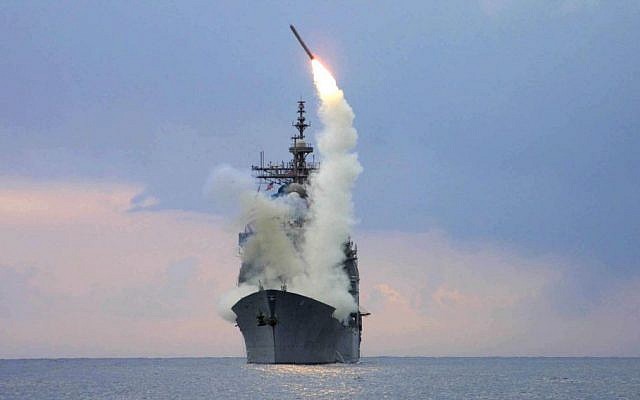Table Of Content
- This Is Not Your Father’s Tomahawk Cruise Missile
- North Korea says it tested ‘super-large’ cruise missile warhead and new anti-aircraft missile
- Why have I been blocked?
- The Tomahawk Missile in Use
- U.S. Navy Trains JMSDF Sailors on Tomahawk Cruise Missile
- What is the Maritime Strike Tomahawk cruise missile?

The Persian Gulf War also saw the first coordinated Tomahawk and manned-aircraft strike in history. Tomahawks were subsequently used extensively in Iraq to enforce “no-fly zone” operations in the early 1990s and during the Iraq War (2003–11). They were also used in Bosnia (1995), Libya (1996 and 2011), Sudan (1998), Yemen (2009), and Afghanistan (1998 and during the Afghanistan War, which began in 2001). Navy sought a precision land attack cruise missile capable of a much smaller CEP. Tensions on the Korean Peninsula are at their highest in years, with North Korean leader Kim Jong Un dialing up his weapons demonstrations, which have included more powerful missiles aimed at the U.S. mainland and U.S. targets in the Pacific.
This Is Not Your Father’s Tomahawk Cruise Missile
Additionally, it flies at an altitude of between 100 and 300 feet, much lower than conventional fighter aircraft. In 1995, the US agreed to sell 65 Tomahawks to the UK for torpedo-launch from their nuclear attack submarines. After achieving flight, the missile's wings are unfolded for lift, the airscoop is exposed and the turbofan engine is employed for cruise flight.
North Korea says it tested ‘super-large’ cruise missile warhead and new anti-aircraft missile
According to PBS, the rocket booster engine launches the Tomahawk in the air (hence all the smoke you may see in news broadcasts or photos you see of the missile) and then its jet engine takes the missile the rest of the way to its target. With the Block V, and through it the Va and Vb variants, likely to remain in service for more than a decade and even up to the 2040s, this would provide vital development time for countries seeking next-generation ASW systems. The Tomahawk was first deployed in combat in the 1991 Gulf War in Operation Desert Storm, with the first salvo launched from the USS Paul F. Foster (DD 964) at Iraqi targets.18 Overall, the mission achieved initial success. At least one ballistic missile launched by Iran was downed by a US Army Patriot battery near Erbil, Iraq. A fleet of F-16s were also involved in downing the attack drones and missiles headed for targets in Israel, a US official told Air and Space Forces Magazine. This website is using a security service to protect itself from online attacks.
Why have I been blocked?
Block IV missiles also feature a camera and datalink, allowing a missile to send imagery back to friendly forces. If a Tomahawk discovers its target already struck or civilians are crowding the target area, the missile can be re-routed to destroy something else. The Tomahawk cruise missile, one of the oldest missiles in U.S. military service, is set to receive a new set of capabilities designed to help keep potential enemies in check. The US Navy placed a $338m contract with Raytheon in June 2012 for the delivery of 361 Tomahawk Block IV tactical cruise missiles. Another contract worth $254.6m was awarded for Tomahawk Block IV in the same year.

Following the selection, the Army awarded a $339.3 million contract to integrate both weapons for a ground-based launcher by late 2022. Also equipped with the Aegis Combat System and accompanying interceptor missiles, the warship assisted in downing the Iranian-launched ballistic missiles. Japan is accelerating its deployment of long-range cruise missiles capable of hitting targets in China or North Korea, while Japanese troops increasingly work side-by-side with the U.S. and other friendly nations and take on more offensive roles.
U.S. Navy Trains JMSDF Sailors on Tomahawk Cruise Missile - Naval News
U.S. Navy Trains JMSDF Sailors on Tomahawk Cruise Missile.
Posted: Tue, 02 Apr 2024 07:00:00 GMT [source]
Tomahawk Block IV missile demonstrated its moving target capability in tests conducted in February 2015. The US Government approved an agreement in 2003 to deliver 65 Tomahawk Block IV missiles for the UK. In August 2004, the US Navy placed a $1.6bn multi-year procurement contract with Raytheon for 2,200 Tomahawk Block IV missiles.
US to deploy new mid-range missile system in Asia-Pacific by end-2024 - South China Morning Post
US to deploy new mid-range missile system in Asia-Pacific by end-2024.
Posted: Tue, 09 Apr 2024 07:00:00 GMT [source]
The Block Va variants will be named Maritime Strike and have the capability of hitting a moving target. The actual payload of the Tomahawk can consist of a number of different munitions. But the primary warhead of the Tomahawk is a 1,000-pound high explosive charge. It can also carry cluster munitions consisting of small bomblets, similar to the ATACMS currently used in Ukraine. For explosive force, Tomahawks were more than enough to disable runways or sink ships.
President Ronald Reagan thought so, and he re-activated four World War II-era Iowa-class battleships (the Missouri, New Jersey, Wisconsin, and Iowa), and the Navy fitted their already formidable weapons arrays with Tomahawk missile batteries. Submarine-launched Tomahawk missiles entered service in 1983 with conventional (i.e., nonnuclear) land-attack and antiship missile variants, as well as with a land-attack missile carrying a nuclear warhead. The nuclear variant has since been retired, and a land-attack cluster-bomb variant that disperses bomblets has been added. By the start of the Persian Gulf War in 1991, Tomahawks had been fitted to surface ships.
Early systems, such as the Matador, Snark, and the ambitious Navaho, lived on in newer operational versions like the Hound Dog, which flew aboard B-52 long-range strategic bombers. Then, in the 1970s, the Air Force debuted the Air Launched Cruise Missile (ALCM) that bore a close resemblance in performance and capabilities to the Tomahawk. Despite its age, the Tomahawk has stayed in the game through a series of progressive upgrades. The original Block I version included both nuclear-tipped and anti-ship versions of the missile. Block II introduced land attack capabilities, like those demonstrated during the 1991 Gulf War, with missiles striking Iraqi Air Force airfields and daytime targets across the Iraqi capital of Baghdad.
Saturation bombing also requires the use of a pilot and crew, which endangers personnel. In 2017, Raytheon’s Tomahawk program manager told reporters at an event at the missile plant in Tucson, Ariz., that the navigation system upgrades will ensure the missile can strike targets even if GPS is taken down. Today’s guided missile cruisers carry 122 silos, while destroyers carry between 90 and 96 silos. Theoretically, a cruiser could carry up to 122 Block Va missiles, though a more rounded mix of all of the above is preferred. Raytheon received a $349m contract for phase two of the Maritime Strike Tomahawk Rapid Deployment Capability to improve the Tomahawk cruise missile system in August 2019. Work will be executed in various locations across the US until February 2023.
Tomahawks are launched vertically from ships, but they can be launched horizontally from torpedo tubes on attack submarines or from external launchers attached to a submarine’s hull. Thereafter it is powered by a turbofan engine that does not emit much heat, which makes infrared detection difficult. It can also elude detection by radar because it has a small cross section and operates at low altitudes. As the TERCOM scans the landscape, the Tomahawk missile is capable of twisting and turning like a radar-evading fighter plane, skimming the landscape at an altitude of only 30–90 metres (100–300 feet). Unlike the Navy, however, the Air Force kept a hand in cruise missile technology.
The Virginia class submarines and the Royal Navy Astute class submarines were also fitted with new vertical launch modules for Tomahawk missile. The newest variant adds upgraded navigation and communications gear to older Tomahawks, electronics that, according to Defense News, make it easier to work through electronic warfare jamming and more difficult for enemy radars to detect. That’s important, because once detected, subsonic cruise missiles are relatively easy to shoot down. The missile can be launched from over 140 US Navy ships and submarines and Astute and Trafalgar class submarines of the Royal Navy.

No comments:
Post a Comment